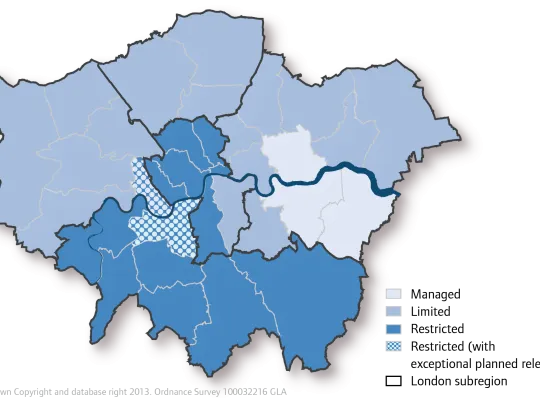
Policy 4.4 Managing industrial land and premises
Policy
Strategic
A The Mayor will work with boroughs and other partners to:
a adopt a rigorous approach to industrial land management to ensure a sufficient stock of land and premises to meet the future needs of different types of industrial and related uses in different parts of London, including for good quality and affordable space
b plan, monitor and manage release of surplus industrial land where this is compatible with a) above, so that it can contribute to strategic and local planning objectives, especially those to provide more housing, and, in appropriate locations, to provide social infrastructure and to contribute to town centre renewal.
LDF preparation
B LDFs should demonstrate how the borough stock of industrial land and premises in strategic industrial locations (Policy 2.17), locally significant industrial sites and other industrial sites will be planned and managed in local circumstances in line with this strategic policy and the location strategy in Chapter 2, taking account of:
a the need to identify and protect locally significant industrial sites where justified by evidence of demand
b strategic and local criteria to manage these and other industrial sites
c the borough level groupings for transfer of industrial land to other uses (see Map 4.1) and strategic monitoring benchmarks for industrial land release in supplementary planning guidance
d the need for strategic and local provision for waste management, transport facilities (including inter-modal freight interchanges), logistics and wholesale markets within London and the wider city region; and to accommodate demand for workspace for small and medium sized enterprises and for new and emerging industrial sectors including the need to identify sufficient capacity for renewable energy generation
e quality and fitness for purpose of sites
f accessibility to the strategic road network and potential for transport of goods by rail and/or water transport
g accessibility to the local workforce by public transport, walking and cycling
h integrated strategic and local assessments of industrial demand to justify retention and inform release of industrial capacity in order to achieve efficient use of land
i the potential for surplus industrial land to help meet strategic and local requirements for a mix of other uses such as housing and, in appropriate locations, to provide social infrastructure and to contribute to town centre renewal.
Supporting text
4.18 Even an increasingly service-based economy needs space for less high-value activities crucial to sustaining the city’s metabolism, including ‘services for the service sector’, manufacturing and maintenance, waste management and recycling, wholesale and logistics. Sufficient space to accommodate demand for workspace suitable for SMEs and for new and emerging industries is also required including for the needs of micro-firms.
4.19 The Mayor will promote a rigorous, evidence based approach to reconcile demand and supply of industrial land and to take account of the needs of industrial and related uses including waste management in terms of clustering, capacity, environment, accessibility and cost requirements through three types of location:
- strategic industrial locations (see Policy 2.17)
- locally significant industrial sites, and
- other industrial sites.
4.20 To justify strategic recognition and protection, locally significant industrial sites must be designated on the basis of robust evidence demonstrating their particular importance for local industrial type functions. Inner London sites providing sustainable distribution services for the Central Activities Zone and Canary Wharf may be particularly appropriate for this designation. Boroughs should make explicit in DPDs the types of uses considered appropriate in locally significant industrial sites and distinguish these from more local industrial areas. In developing criteria to guide the management of these and more local capacity, boroughs should take into account guidance in the Mayor’s Land for Industry and Transport SPG.
4.21 Taking account of trends in the wide range of industrial type activities and scope for more efficient use of industrial capacity, as well as more specific requirements for waste management and recycling (Chapter 5), research suggests industrial land use change should be monitored against benchmarks based on an average, pan-London annual net release of 37 ha 2011-2031[1]. Informed by the research and consultation on the Mayor’s Land for Industry and Transport SPG, the broad borough level groupings for transfer of industrial land to other uses in Map 4.1 indicate that the scope for transfer is greatest in east and parts of inner west London, with more limited scope in north and outer west London and restricted scope for release elsewhere. This will require careful management by boroughs in collaboration with the Mayor.
Map 4.1 Borough level groupings for transfer of industrial land to other uses

4.22 The monitoring benchmarks, the borough level groupings and implementation of industrial land release will be kept under review and updated to roll the benchmarks forward to cover the period up to 2036 through supplementary guidance. Where appropriate the Mayor will work with partners to develop more detailed frameworks to manage the release of land, where this will not prejudice his wider planning objectives.
4.23 Redevelopment of surplus industrial land should address strategic and local objectives particularly for housing, and for social infrastructure such as education, emergency services and community activities. Release of surplus industrial land should, as far as possible, be focused around public transport nodes to enable higher density redevelopment, especially for housing. In locations within or on the edges of town centres, surplus industrial land could be released to support wider town centre objectives (see Policy 2.15).
4.24 The Mayor seeks to retain an efficient wholesale market function to meet London’s requirements. Redevelopment of any of the markets should not compromise opportunities to consolidate composite wholesale market functions to meet London’s long term wholesaling needs at Western International, New Covent Garden and New Spitalfields[2].
[1] Mayor of London. Supplementary Planning Guidance, Land for Industry and Transport. GLA, 2012. Roger Tym & Partners, King Sturge. Industrial Land Demand and Release Benchmarks in London. GLA 2011
[2] URS. London Wholesale Markets Review. GLA, 2007
Need a document on this page in an accessible format?
If you use assistive technology (such as a screen reader) and need a version of a PDF or other document on this page in a more accessible format, please get in touch via our online form and tell us which format you need.
It will also help us if you tell us which assistive technology you use. We’ll consider your request and get back to you in 5 working days.